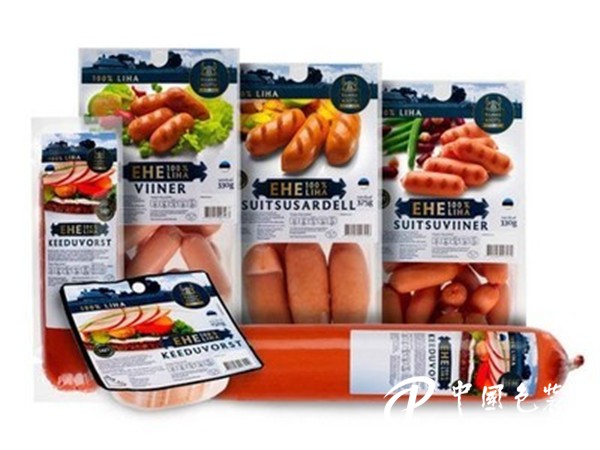[China Packaging Network News] The purpose of packaging is to prevent bacteria from contaminating the product, thus ensuring product quality. Packaging can also play an advertising role to attract consumers' attention. In the stages of manufacturing, distribution, sales and consumption, that is, from the factory to the consumer, the product has to be in contact with human hands. Therefore, pollution may occur at any time. Therefore, we must prevent bacterial contamination through packaging.
Most of the packaging used for meat products is plastic. Plastics have a wider range of packaging properties than paper and metal packaging materials, and a packaging material can have several properties at the same time. Moreover, the lamination and coating techniques of thin plastic glands can also supplement the insufficiency of single sheets, and laminating/coating techniques can be used to develop films for various purposes.

Oxygen barrier
Is to cut off the permeability of oxygen. Not only oxygen, but also other gases. The amount of plastic film that passes through is not related to the molecular size of the gas. Usually it is done in two steps, initially the gas dissolves in the film's molecules and then penetrates through the diffusion. The oxygen barrier properties of the film apply to all meat products other than raw meat. Especially in the vacuum packaging, inflatable packaging is more important. As a result of oxygen, hemoglobin is changed to ferrous heme, which causes product discoloration, promotes fat oxidation, and proliferation of aerobic microorganisms. Therefore, the prevention of contact between products and oxygen is extremely important for maintaining product quality and improving preservation.
Moisture resistance
It is the nature of blocking water vapor transmission. When the film molecule contains no hydrophilic hydroxyl group or carboxyl group, it is considered to have good moisture resistance. Moisture resistance changes greatly with temperature. The moisture resistance of the film is suitable for all meat product packaging. If the product moisture passes through the inside of the packaging film in the form of water vapor, or the product absorbs water vapor that penetrates from the outside, the flavor, texture, and content of the product will also change. In particular, the packaging of dried sausages with little moisture content and the prevention of the natural loss of quantitative products are extremely important.
Shading
In particular, light having a wavelength of 320 to 380 nm that is optically active in ultraviolet rays is shielded. This property is very important for vacuum packed sliced ​​products and colored products, smoked products. The transparent film does not shield the UV light. Although HDPE is somewhat opaque, the film is opaque. There are many ways to prevent UV transmission. One of them is to add UV absorbers to the packaging material. However, in recent years, food packaging materials have banned the use of UV absorbers. Therefore, a method of shading using the properties of light was also developed. This method is a method of absorbing light or reflecting light by a printing ink, or using a satin-finishing cylinder to mechanically emboss an embossed pattern on a film surface to reflect light. When printing inks are used, black and white have the effect of absorbing light or reflecting light. In addition to other inks, even if there are shades of light, it will not achieve the desired effect. Except for black, almost all light colors do not absorb light, and dark colors are black, blue, green, and yellow, and their shading properties deteriorate in turn, and red and purple have no effect. In the general printing, the light-shielding film is opaque. The disadvantage is that the product in the bag is invisible. In order to compensate for the defects of opaque films, a method for ultra-micronizing inks has recently been developed. Within the film, light is scattered and shielded by short wavelength ultraviolet rays, which allows visible light of longer wavelengths to pass through, and can also be seen in products in packaging bags. Printing film.
Impact resistance
This property applies to all packages. Especially for heavy things, tight packaging without gaps between casings and products is even more important. Impact resistance of packaging materials can be guaranteed by the balance of tensile strength, tensile elongation and impact strength of the material. Such films include polyvinyl alcohol, polyvinyl chloride, polyvinylidene chloride, stretched nylon, and the like.
cold resistance
Even at low temperatures, the film does not become brittle and retain its strength and impact resistance properties. Generally, there is no problem in preserving meat products at -10 to 0°C, but if frozen meat products are stored at -15°C, the cold resistance of the film must be considered because it directly affects the sealing strength. Cold-resistant packaging includes polyamide resin, polyethylene (low density), polyester, polypropylene (stretch), and polypropylene (non-stretch).
Heat resistance
It refers to a property that the softening point is high and that it does not deform even after heating (for example, polyvinyl chloride). Since the product swells when heated, the heat resistance of the film must be ensured. This property is suitable for secondary sterilization packaging. Polyester, polyvinylidene chloride, polypropylene (non-stretch), polypropylene (stretch), and polyethylene (high density) have better heat resistance.
Formability
Refers to the use of air to soften the heated film after blow molding (air-pressure forming), or by suction (vacuum forming), so that the film is formed along the forming mold (packed along the product during shrink packaging) properties. Good moldability means that the heated film can be uniformly stretched on all four sides with a small force.
Article source: China Packaging Network If you need to republish articles, please indicate the source or keep the original source path